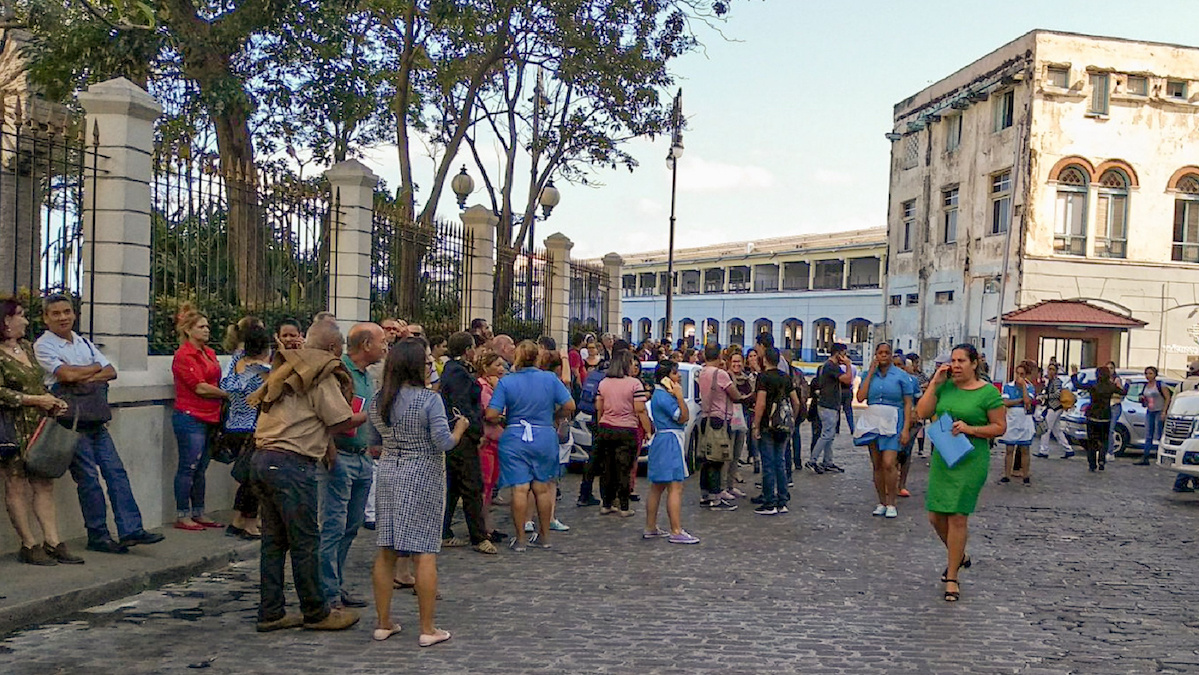
7.7 Earthquake in Caribbean Prompts Evacuations as Far Away as Miami

Workers evacuate the Lonja del Comercio (Commerce Market) in Havana, Cuba after an earthquake rattled the island Tuesday. ADALBERTO ROQUE / AFP via Getty Images
A 7.7 magnitude earthquake shook the Caribbean Tuesday, rattling people from Miami to Mexico.
The quake struck at 2:10 p.m. and had its epicenter 86 miles northwest of Montego Bay, Jamaica and 87 miles southwest of Niquero, Cuba. It prompted evacuations in Miami and opened sinkholes in the Cayman Islands, but so far there have been no reports of major damages or injuries.
“This one was serious. It put the fear of God into many people today,” Jamaican ad executive Knolly Moses told NPR.
A M7.7 has been reported northwest of Jamaica. It appears to be the transform fault boundary between the North American and Caribbean plates. pic.twitter.com/jpVq5fmtJg
— Dr. Lucy Jones (@DrLucyJones) January 28, 2020
The Pacific Tsunami Warning Center initially warned that “hazardous tsunami waves” could impact Belize, Cuba, Honduras, Mexico, the Cayman Islands and Jamaica, BBC News reported. However, those warnings were later withdrawn.
The earthquake was felt in Kingston, Jamaica and Havana, Cuba. It was also strongly felt in Cuba’s largest eastern city, Santiago, The Associated Press reported. However, the colonial city emerged unscathed.
“It felt very strong but it doesn’t look like anything happened,” Belkis Guerrero, who works at a Roman Catholic cultural center there, told The Associated Press.
In the Cayman Islands, the shaking blew the covers off manholes and blasted sewage into the streets, Cayman Islands hospital psychiatrist Dr. Stenette Davis told The Associated Press. The Cayman Islands also felt a series of aftershocks — one reached a magnitude of 6.1. Water was shut off to most of Grand Cayman Island and schools were closed Wednesday.
Big #earthquake off coast of Jamaica. This photo was taken at Cricket Square in George Town, Cayman Islands. Bricks lifting and sink holes. #Tsunami warning issued for Jamaica, Cayman Islands and Cuba. https://t.co/Y5fhyzxIMl pic.twitter.com/205GIGfv96
— Naomi Yamamoto (@naomiyamamoto) January 28, 2020
Cayman Compass editor-in-chief Kevin Morales said that the island was unaccustomed to earthquakes and that newspaper staff were not at first sure what they were experiencing.
“It was just like a big dump truck was rolling past,” Morales told The Associated Press. “Then it continued and got more intense.”
In Miami, meanwhile, the shaking prompted evacuations from at least eight high-rise buildings in downtown Miami, Miami City Commissioner Ken Russell told CNN affiliate WPLG, as the main network reported.
High-rise employee Jose Abreu at first thought the vibrations he felt were from a fan.
“I thought it was the fan acting up on me. I didn’t think anything of it,” he said. “I just went along, until the building announcement came through the speakers and I just evacuated in the back of the building.”
Ryan Gold of the U.S. Geological Survey told the Miami Herald that it was not surprising that the quake was felt in Miami, as BBC News reported.
“It’s a very large earthquake which can produce a lot of seismic energy,” he said.
Shaking from the 7.7 magnitude Caribbean Earthquake felt in high-rises as far north as Aventura, FL, just north of Miami.
📹: Michael L. pic.twitter.com/Ln41irg33l
— Brandon Orr (@BrandonOrrWPLG) January 28, 2020
The earthquake was also felt in five Mexican states including Veracruz, on the Gulf Coast, The Associated Press reported.
- Scientists Discover 'Stormquakes,' Small Earthquakes Triggered by ...
- Powerful Earthquake Kills at Least Six in Mexico - EcoWatch
- Are there earthquakes in Florida? Experts discuss | Miami Herald
- How our internet cables can detect underwater earthquakes
- Fiber-optic cables record underwater earthquakes on the ocean floor
- 7.7 magnitude earthquake causes evacuations in Miami - YouTube
- Caribbean quake sways buildings in Cuba, Jamaica, even Miami ...

 233k
233k  41k
41k  Subscribe
Subscribe 